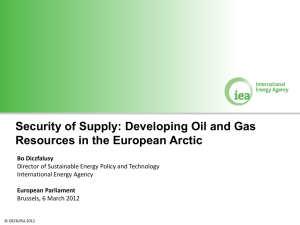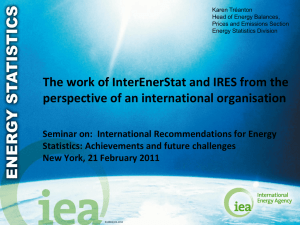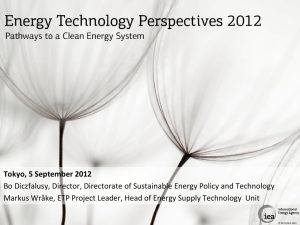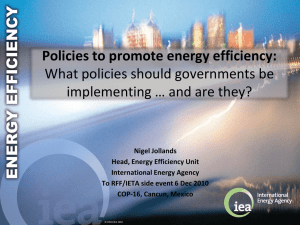Global Energy Dynamics: Outlook for the Future
advertisement
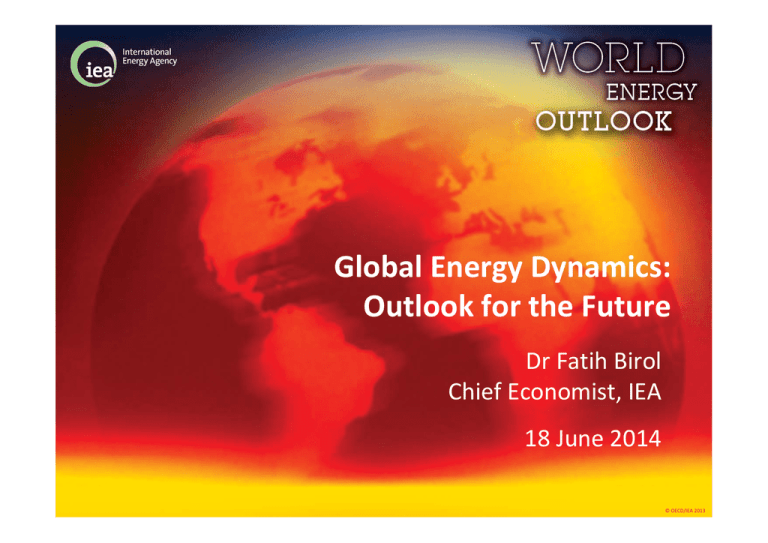
Global Energy Dynamics: Outlook for the Future Dr Fatih Birol Chief Economist, IEA 18 June 2014 © OECD/IEA 2013 The world energy scene today Some long‐held tenets of the energy sector are being rewritten Countries are switching roles: importers are becoming exporters… … and exporters are among the major sources of growing demand New supply options re‐orientate the energy trade map But there still remains a major disconnect between climate change goals & actions being taken to meet them Energy prices add to the pressure on policymakers Sustained period of high oil prices without parallel in market history Large, persistent regional price differences for gas & electricity The geopolitics of energy are being further complicated as new tensions add to other unresolved concerns © OECD/IEA 2013 The energy mix is slow to change Growth in total primary energy demand 1987‐2011 Gas 2011‐2035 Coal Renewables Oil Nuclear 500 1 000 1 500 2 000 2 500 3 000 Mtoe 25 years ago the share of fossil fuels in the global mix was 82%; it is the same today & the strong rise of renewables in the future only reduces this to around 75% in 2035 © OECD/IEA 2013 Unconventional oil and gas has made a major contribution to global production US shale gas and shale oil production increases: 2005‐2014 3.0 mb/d bcm 300 250 2.5 200 2.0 150 1.5 100 1.0 50 0.5 0 0.0 Gas Oil Growth in US shale gas since 2005 equals the current output of Qatar + Kuwait + UAE + Iraq; while shale oil output is equal to that of Iraq while US shale oil output is now equal to Iraqi oil production © OECD/IEA 2013 Is shale oil the only reason why US oil imports are shrinking rapidly ? Reductions in US oil imports in 2035 relative to today Increased oil supply Demand‐side policies 35% 57% 8% Natural gas use in transport US oil imports are set to plummet due to increasing oil supplies & recently adopted policies to improve efficiency of cars and trucks © OECD/IEA 2013 Two chapters to the oil production story Contributions to global oil production growth Middle East 2013‐2025 2025‐2035 Brazil United States Rest of the world ‐2 0 2 4 6 8 mb/d The United States (light tight oil) & Brazil (deepwater) step up until the mid‐2020s, but the Middle East is critical to the longer‐term oil outlook © OECD/IEA 2013 Oil use grows, but in a narrowing set of markets Oil demand by region sector mb/d 105 100 Other Gasoline 95 Diesel 90 Other Middle East India 85 OECD China 80 75 2012 Transport Petrochemicals Other sectors 2035 China becomes the largest consumer of oil by 2030, as OECD oil use drops; demand is concentrated in transport, where diesel use surges by 5.5 mb/d, & petrochemicals © OECD/IEA 2013 Turbulent times for the refining sector Refinery capacity and operation mb/d 105 Other Middle East India New refinery capacity China 100 95 90 Current spare & excess capacity 85 80 Oil bypassing refineries Spare & excess capacity, 10 mb/d at risk of closure by 2035 Oil demand Oil processed by refineries 75 70 2012 2035 More oil bypassing the refining system and new capacity in growing non‐OECD markets piles pressure on existing refiners, especially in Europe © OECD/IEA 2013 Regional natural gas prices: who has the energy to compete? Natural gas prices by region $/MBtu 20 18 16 14 12 10 8 6 4 2 0 2013 2035 European Union Japan United States Regional differences in natural gas prices narrow from today’s very high levels but remain large © OECD/IEA 2013 Energy‐intensive industries need to count their costs Share of energy in total production costs for selected industries 10% 20% 30% 40% 50% 60% 70% 80% 90% Petrochemicals Fertilisers Aluminium Cement Iron & steel Pulp & paper Glass Energy‐intensive sectors worldwide account for around one‐fifth of industrial value added, one‐quarter of industrial employment and 70% of industrial energy use. © OECD/IEA 2013 LNG from the United States can alleviate strain on the gas markets, but is no silver bullet Indicative economics of LNG export from the US Gulf Coast $/MBtu 18 15 12 $/MBtu 12 9 9 6 6 3 3 To Asia Average import price Liquefaction, shipping & regasification United States price To Europe New LNG supplies accelerate movement towards a more interconnected global but high costs of transport between regions mean no single global gas price market, but high costs of transport between regions mean no single global gas price © OECD/IEA 2013 US emissions on a downward trend Energy‐related CO2 emissions in the United States Gt CO2 6.5 6.0 5.5 5.0 4.5 4.0 1990 1995 2000 2007 2012 2013 CO2 emissions fell sharply since the shale gas revolution, but rebounded last year on the back of a partial gas‐coal switch and increased industrial activity © OECD/IEA 2013 The slowdown in Chinese coal demand caught industry off‐guard Coal demand in China: real demand vs historical trend Real consumption Mt 4400 Historical trend 4200 Curbing in China ≈ 20 times the increase in US exports in 2012 4000 3800 3600 3400 3200 3000 2010 2011 2012 2013 China’s move away from coal will have a much greater impact on global coal markets than the US shale gas revolution © OECD/IEA 2013 Concluding remarks The shale revolution is having an unprecedented impact on the global energy landscape, economy and geopolitics Middle East oil will continue to be indispensible to world markets – the right signals to invest must be sent New geography and composition of oil demand and supply confront the world’s refiners with a complex set of challenges While US natural gas prices may rise, large disparities between regions will persist Europe’s energy strategy needs to focus on competitiveness & energy security, in addition to climate concerns © OECD/IEA 2013
